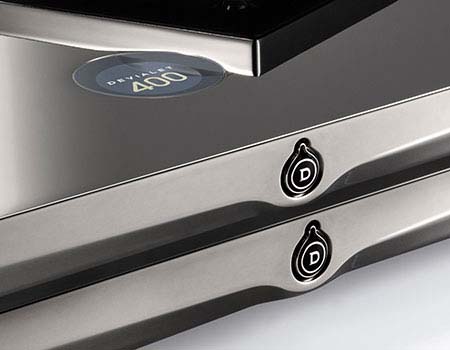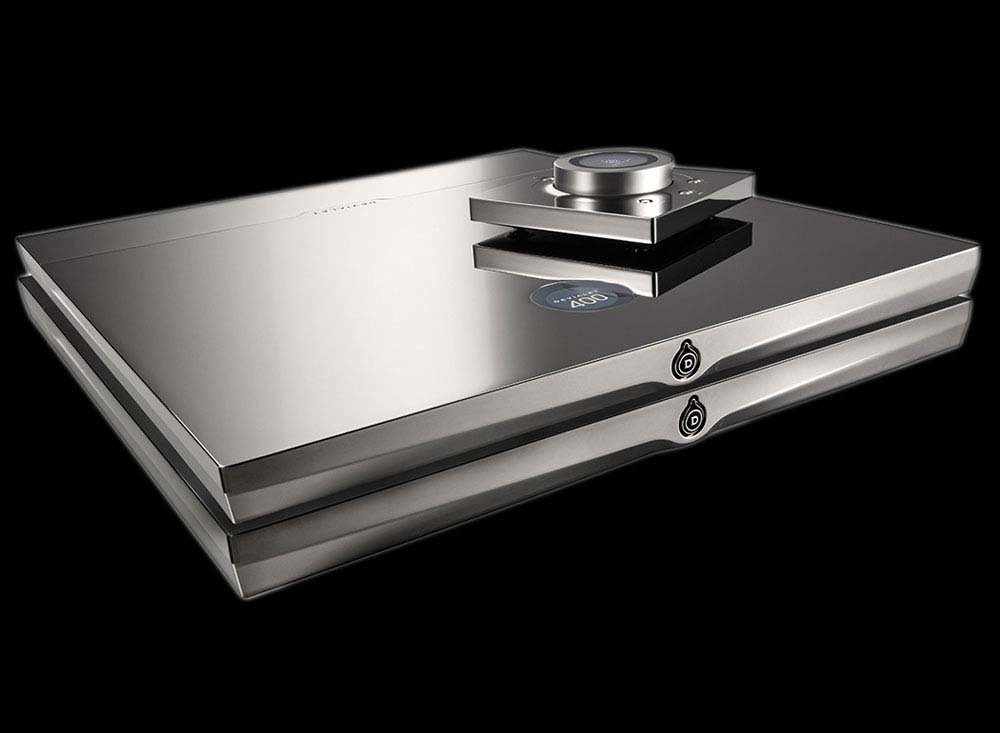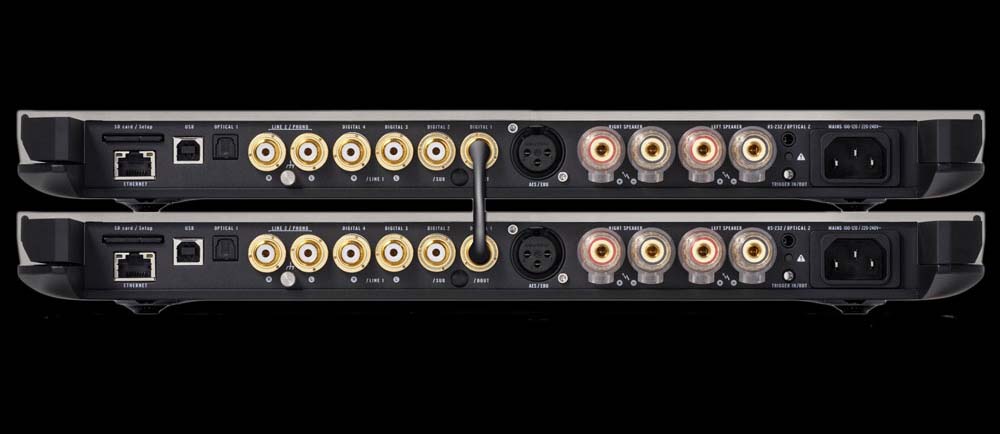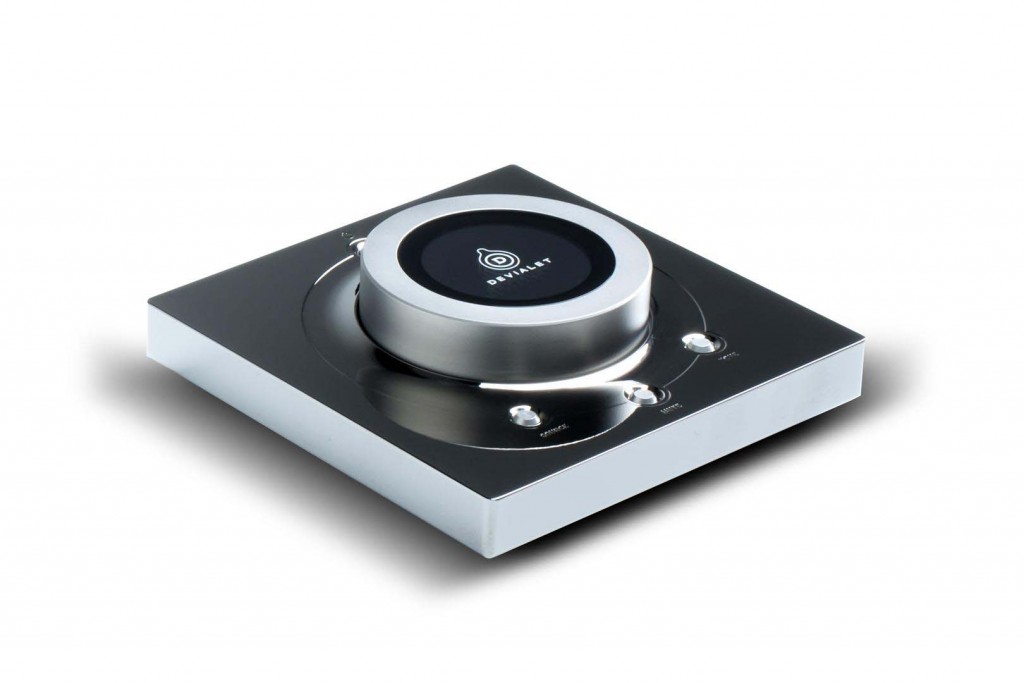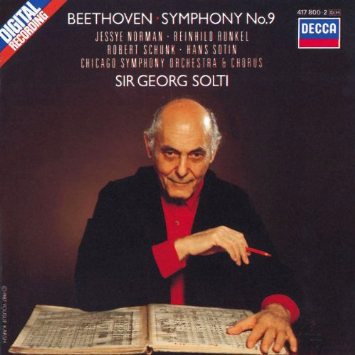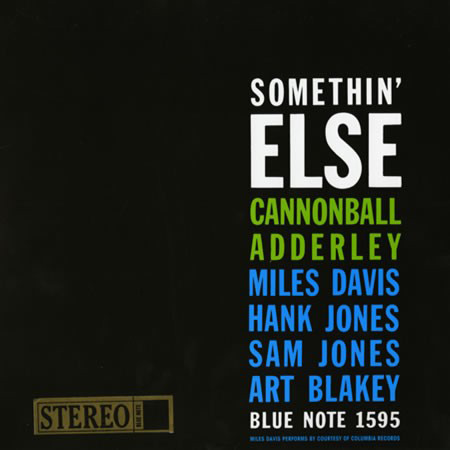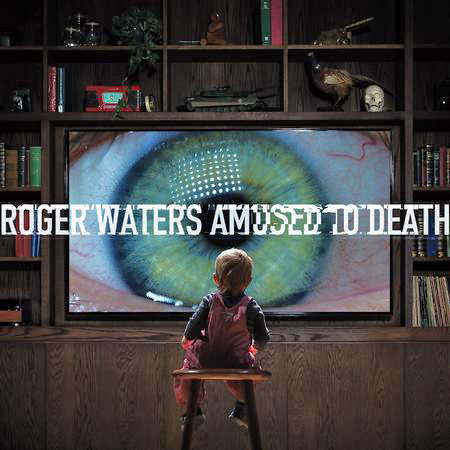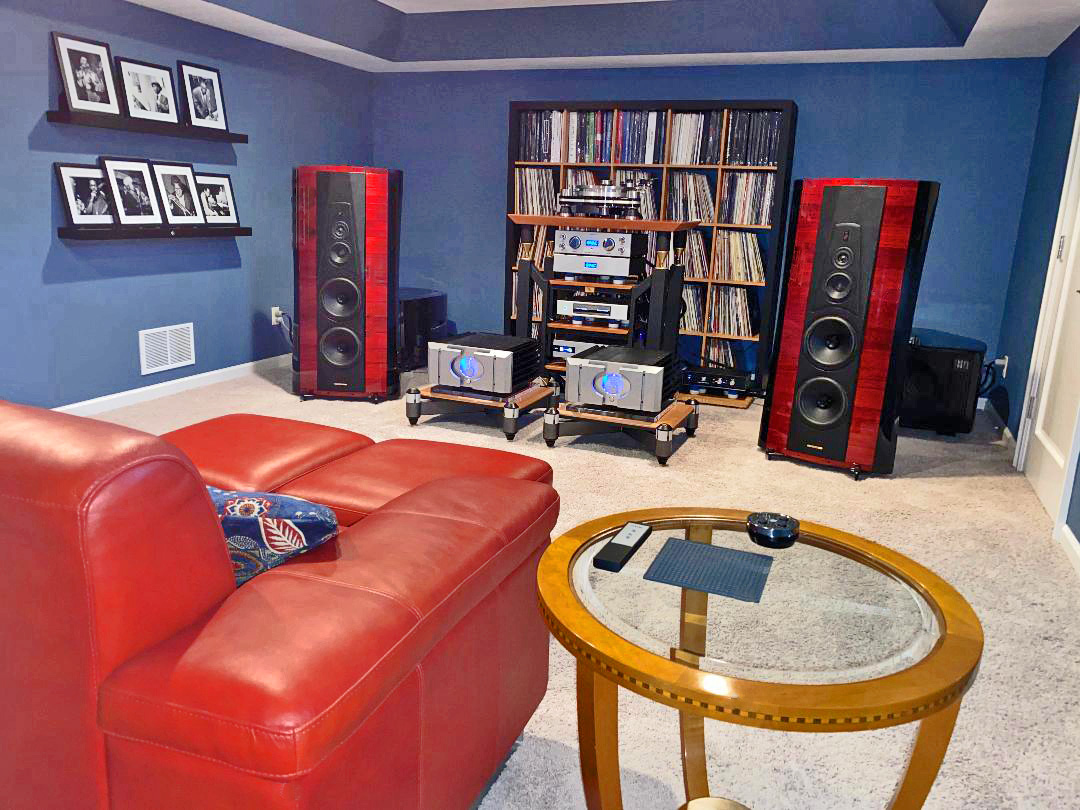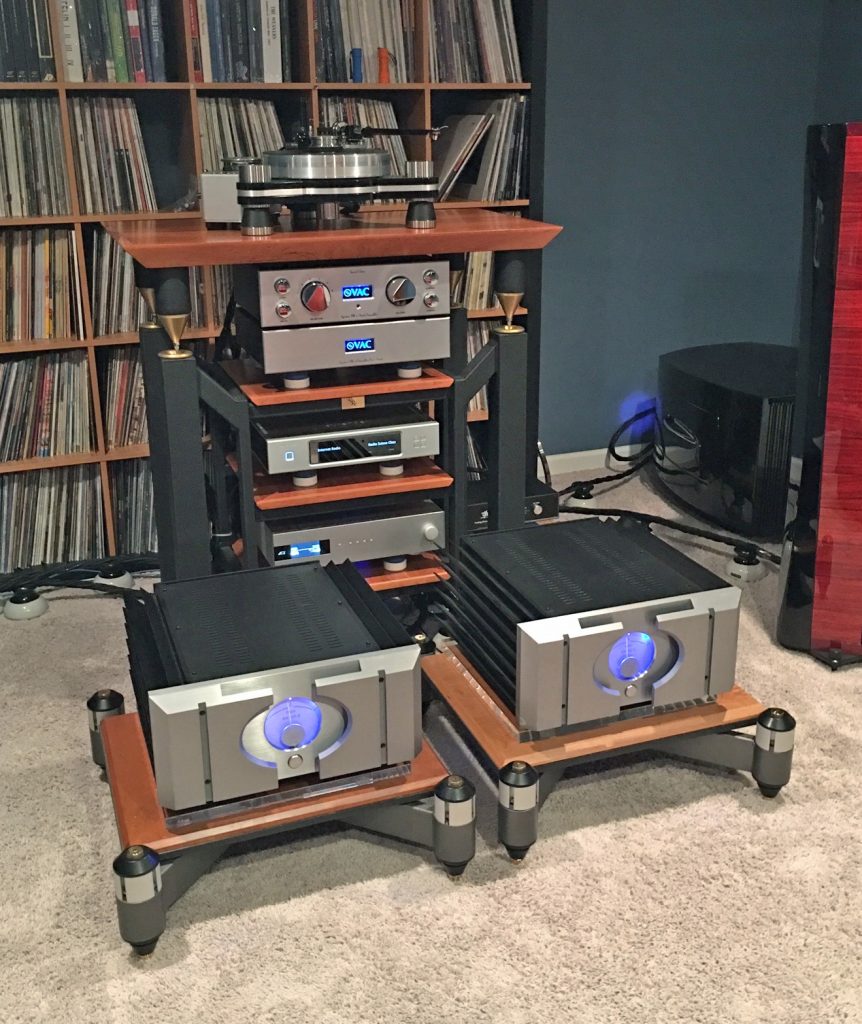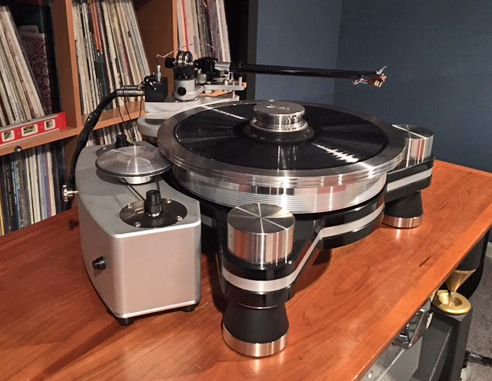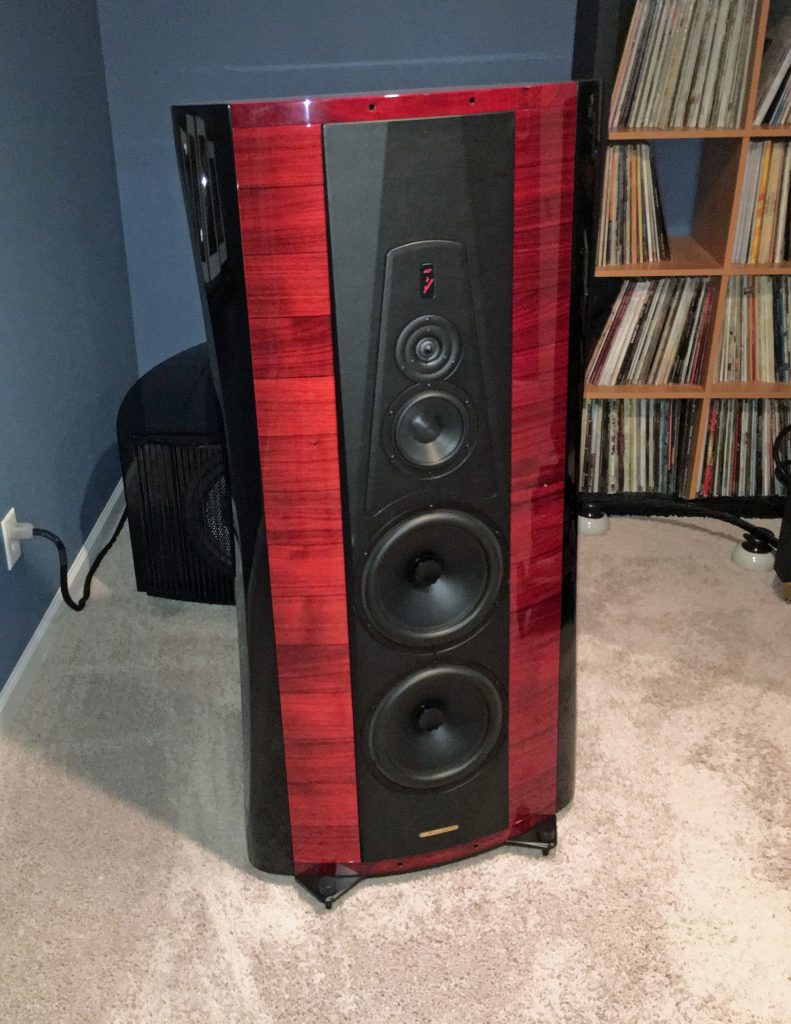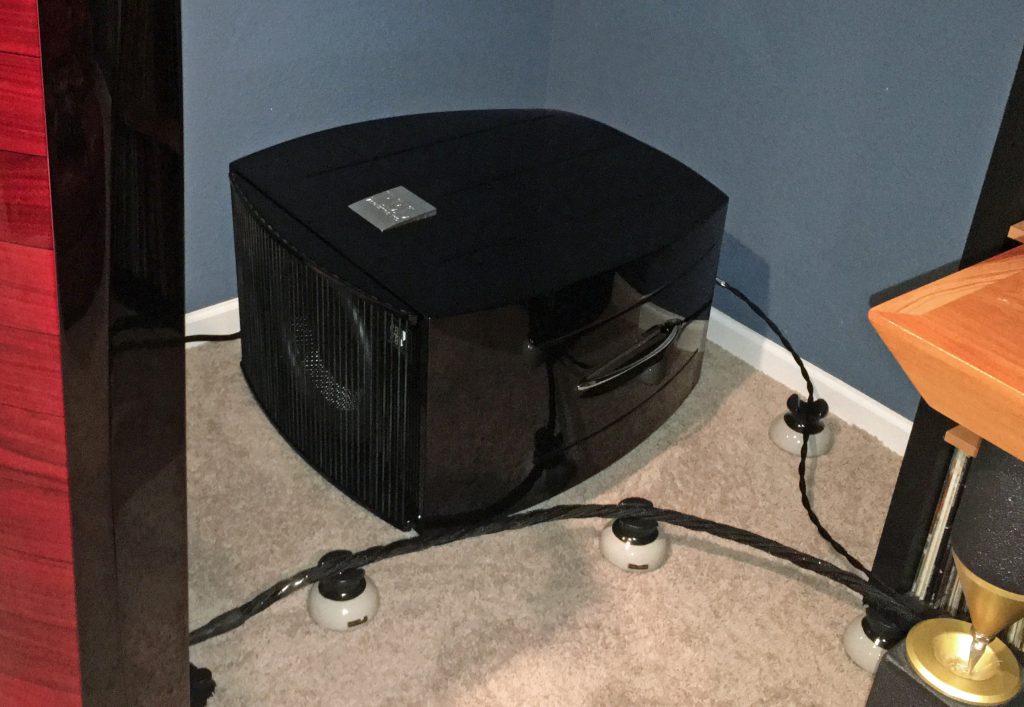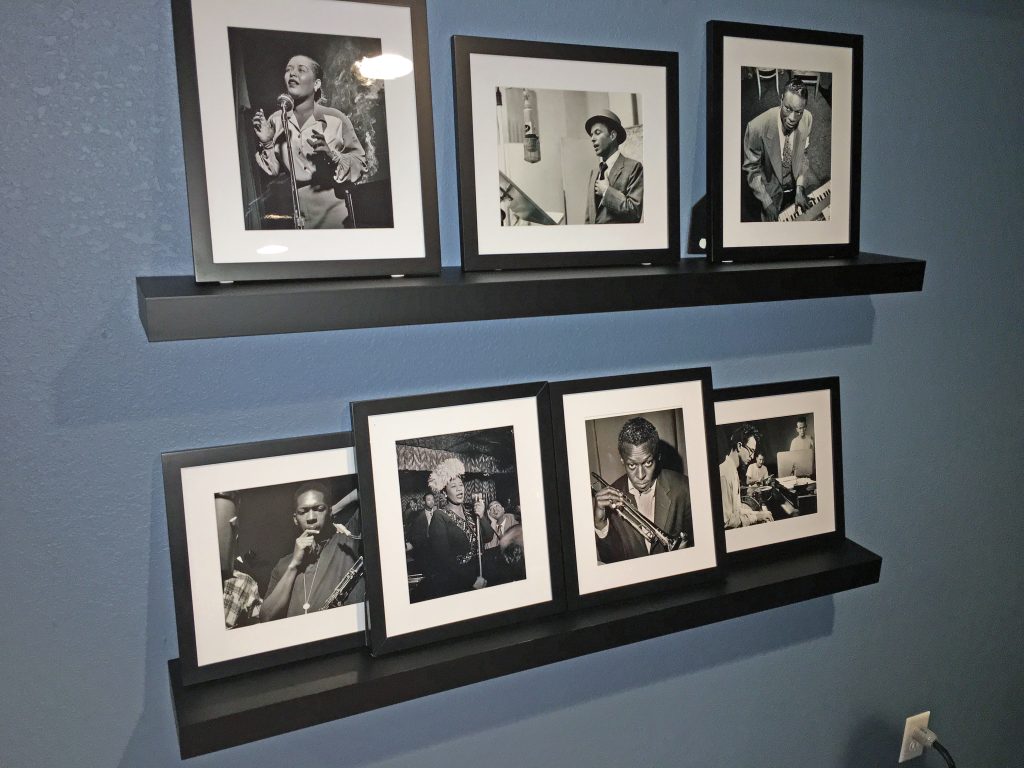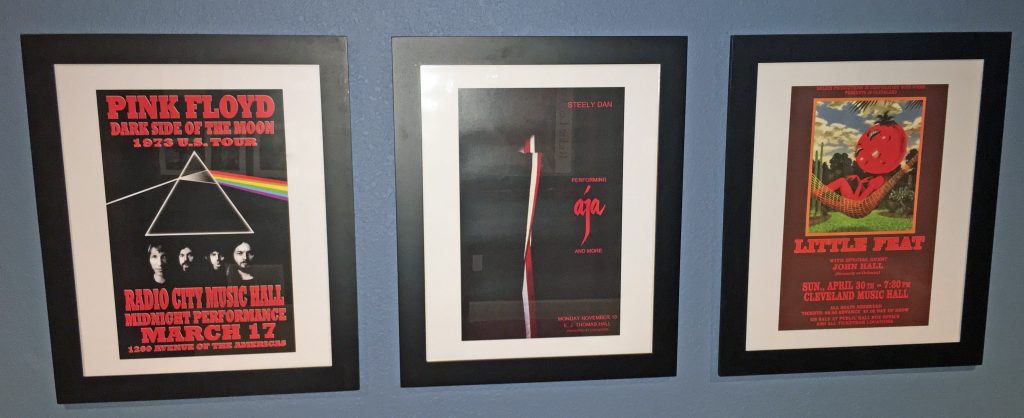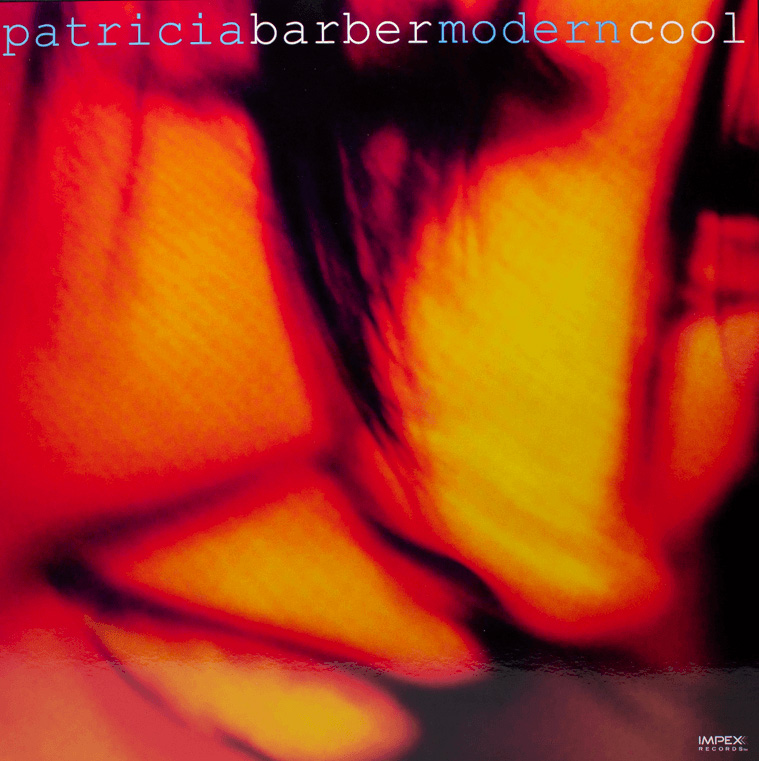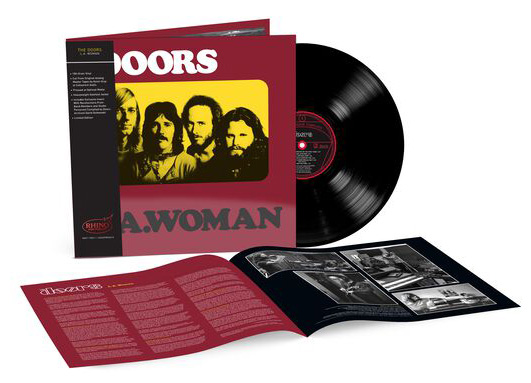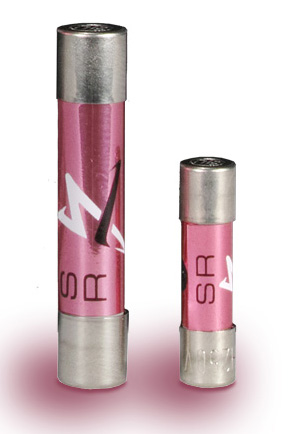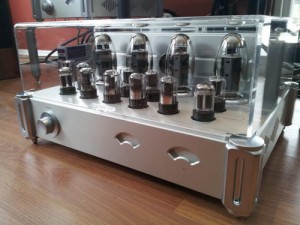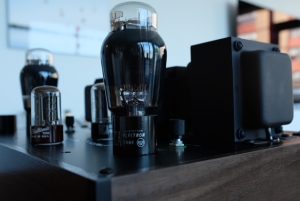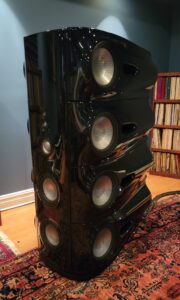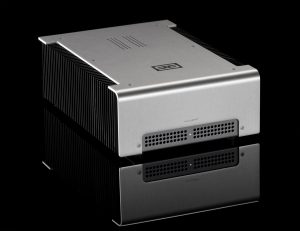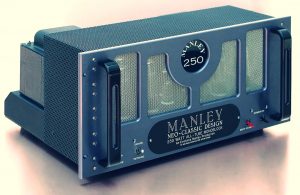I am a huge fan of Integrated Amplifiers. I am a firm believer that less is more. Fewer boxes, cables and resonance control devices is a big plus in my book. Past reviews for models from Vitus, D'Agostino, Pass Labs, Simaudio, BMC, Marantz and more have established several reference standards for sound quality—even when compared to separate components. With its unique Class A/D hybrid design and generous feature set, Devialet is an exciting new player and an important bench mark for my Integrated Amplifier review series.
If you follow the audiophile press, Devialet has received considerable attention and much praise. From any perspective, it is all well-earned and fully justified. My own experience with Devialet has me rethinking my listening priorities. In hockey parlance, the Devialet 400 has me "standing on my head".
Aesthetics and ergonomics can compete with virtually anything—integrated or separates. The high gloss black chrome finish and clean lines will dazzle your senses. An outstanding level of system flexibility is provided for both analog and digital connectivity. Multiple inputs and outputs can be programmed for your specific system configuration and listening needs.
Even the design and performance of the remote is like nothing I have encountered before. No concerns about distance and need to point—it's all omnidirectional and RF driven. Programmable functions like volume, source, balance, phase, tone control and subsonic filter are at your fingertips. And the volume wheel—wickedly brilliant!
It does not end there. Through their Speaker Active Matching (SAM) software, Devialet provides an additional tool that can correct performance abnormalities specific to your speaker brand and model. Even analog fanatics will find that cartridge setup flexibility (for gain and loading) and the drop dead quiet performance of the phonostage are absolutely amazing. Let's not forget the Record Active Matching (RAM) feature for implementing the correct RIAA curves for your specific record collection, the DSD Core feature for transporting DSD over PCM for your high resolution DSD files, or the AIR feature for music streaming up to 24-bit/192kHz. Did you say you have two subwoofers? The Devialet 400 can provide connectivity for both with high and low pass filters, crossover and delay settings.
All of these features are primarily software driven so as interfaces and technology evolves, so will your amplifier through new firmware updates. This also means that sound performance could and should also evolve. This is a huge design advantage for long term sustainability, something that most audiophiles seem to ignore but I feel it's becoming more and more important with escalating MSRP's. Cutting edge stuff.
Is this the future of high end audio and music reproduction in general? If minimalist aesthetics and feature rich integrated solutions are your thing, look no further. Yes, the Devialet 400 is a technological tour de force, but I am still old school when it comes to my listening needs and priorities. For me, it still has to be about the sound. Without letting the cat out of the bag completely, let me just say upfront that the sound was exemplary. Exemplary but different. So different from my ingrained biases for solid state and tubes, that I am still trying to get my head around what I was hearing.
Review System
- Magico Q7 Speakers
- REL Gibraltar G-2 Subwoofers
- Pass Labs INT-60 Integrated Amplifier
- Vitus RI-100 Integrated Amplifier
- D'Agostino Momentum Integrated Amplifier
- Playback Designs MPS-5 CD/SACD/DAC
- Pass Labs XP-20 Phono Preamp
- VPI Aries Extended Turntable
- VPI 12.6 Memorial Tonearm
- Van den Hul Frog Cartridge
- Synergistic Research Element CTS Power Cords, Interconnects and Speaker Cables
- Synergistic Research Powercell 10 UEF and FEQ - PowerCell Equalizer
- MIT SL-Matrix50 Interconnects and SL-Matrix90 Speaker Cables
- SRA VA Turntable Isolation Base
- Rix Rax Hoodoo Component Rack
- Magico QPod Footers
Caveat Emptor
System synergy and personal taste are critical when evaluating high-end audio products. This review is based on my subjective requirements, my subjective ears, my specific system and my specific listening room. This combination is only one data point of many that exist out there for these components. Please consider my comments and analysis appropriately.
Design
Devialet offers five models—please see below. Each model number reflects the power output for a 6-ohm load. The Devialet 400 and 800 are two chassis or two module configurations. You can evolve a 200 to a 400 by retrofitting with an additional 200 module and software. You can evolve from a 250 to a 800 by retrofitting with an additional 250 module and software. Please note that the Devialet 250 and 800 uniquely include an upgraded machined aluminum case that provides for better thermal and heat dissipation performance.
- Devialet 120 ($6495)
- Devialet 200 ($9495)
- Devialet 250 ($17,495)
- Devialet 400 ($17,495)
- Devialet 800 ($29,995)
Devialet claims that their patented ADH (Analog Digital Hybrid) amplification core which utilizes a circuit design implementing both Class A and Class D in parallel is the key to the unique sound of all their models. The musicality of the Class A (voltage control) and efficiency of the class D (current output) takes the best of both circuit topologies. Total Harmonic Distortion (THD) at .00025% and a signal to noise ratio of 133dB is probably another important factor. I have never heard a blacker more noise free background in my listening room. These specifications are very impressive if not astonishing.
All inputs are processed in the digital domain. Analog inputs are converted to digital via the internal DAC (Burr-Brown PCM1792). You can select a sample rate of 96 or 192kHz. Digital inputs are acceptable up to 24bit/192kHz and are upsampled to 384kHz. A switch-mode type power supply is also utilized to save space and weight. The two modules are linked by a digital interconnect provided by Devialet and manufactured by Crystal Cable. Of course, you have the flexibility to experiment with other brands and models. Linked together, the two modules work in a Master/Companion type configuration.
Network access is possible through an Ethernet connection or via the use of the AIR app which needs to be installed on your PC or MAC. Additional inputs include Asynchronous USB, TosLink, mini-Toslink, and AES/EBU. It is also possible to turn a coaxial input into an output or use the USB port as an output. This might come in handy when trying to digitize vinyl. Analog inputs include one singled ended line level and one single ended phono. Balanced inputs are not provided.
Overall dimensions are 383mm (W) x 383mm (D) x 40mm (H) or approximately 15 inches x 15 inches x 1.6 inches per module. Weight is 5.65 Kg or approximately 12.5 pounds per module. Even the protection and packaging used for shipping all the components is an engineering delight.
Configurator
Thankfully, the Devialet configurator is very user friendly. Even an old codger like me was able to maneuver my way through it without much difficulty. No need to call the kids for this one.
Remember, this is a two module configuration so I needed to follow the process twice for two SD cards (provided by Devialet)—one for each module. I established a user name and password on the Devialet website. I then logged in and worked my way through the menu. The template guided me through all of my settings with a logical progression and excellent definitions for each option. When completed, I saved the configuration to each SD card and placed each into it corresponding Master and Companion module. I then hit the power button. Voila! Success from the get go.
You can experiment and save different configurations and settings. This is very helpful as your system evolves or if you are experimenting with new equipment. I was told that disabling unused inputs and outputs would provide better sound, but I did not find that to be the case. I could not hear any difference. Even so, I turned off everything that was not being used.
SAM
SAM is an acronym for Speaker Active Matching. This software is specific to each speaker brand and model and is designed to address time delays and frequency response errors for frequencies under 200 Hz. SAM-V2 is now also available. Devialet states that SAM-V2 is able to support the most complex speaker designs, even those with passive radiators. Enhancements have also been made for better driver protection and sound when listening at high and low volume settings.
Devialet has an engineering group and several proprietary tools that examine the output characteristics and measurements of each speaker. From this analysis, the SAM software is developed and made available on the Devialet website for downloading to your SD cards via the configuration tool.
Currently, the SAM database contains approximately 200 speakers and counting. This list is also available on the Devialet website. There is a process in place for Devialet owners to vote and request that their speakers be considered for SAM software development. Very democratic.
I have read on the Internet some interesting subjective opinions about SAM. Apparently, depending on the speaker, SAM can make a significant impact or very little. Some claim that bass performance is greatly improved with additional control and impact. I have also heard through the grapevine that several speaker manufacturers are not all that thrilled that Devialet is altering the sound performance of their products and their intended voicing. This is all second hand conjecture of course. You need to hear SAM for yourself. Just my opinion, but I greatly appreciate the flexibility that SAM can provide. Options can sometimes deliver superior solutions.
You can determine your own preference quite easily. By using a button on the remote, you can toggle back and forth between using SAM and not using SAM. Unfortunately, at this time, SAM is not available for my Magico Q7 speakers so I cannot give you my personal opinion on this feature in my system. It is available for the new Magico Q7 MII speakers. I did place a vote and request on the Devialet website. I will keep you posted.
Wire
I would be remiss if I did not mention the wire used in this system. I continue to utilize Synergistic Research CTS Element interconnects, speaker cable and power cords throughout with great success. MIT SL-Matrix50 interconnects and SL-Matrix90 speaker cables were also a great match.
Early on in the review process, it was suggested that I upgrade from a generic AES/EBU digital cable to a Synergistic Research CTS Element AES/EBU digital cable. This was required to link the Devialet 400 to my Playback Designs MPS-5 CD/SACD/DAC. Of course, this allows you to stay all digital without additional analog to digital conversions that would occur with analog inputs.
I feared the worse and the truth quickly materialized. I am new to the digital game for anything other than standard analog connectivity. It is clear that even with digital cables, you need be careful if you seek out the best for your system. There was a dramatic positive difference with the CTS Element AES/EBU cable. This difference struck long and wide across all the traditional audiophile performance variables. I hope to do a more in depth review in the near future.
Proviso
The SACD market is still a relatively small niche, so the following might be a non-issue for those with a CD only library or if you have moved on to computer audio with a laptop or music server. Nevertheless, if you have a large collection of SACDs and want to stay all digital when connecting your SACD player to the Devialet, there are some limitations.
As you probably know, SACDs are DSD based, but they utilize a copy protection or proprietary format developed by Sony. When playing SACDs and using a digital connection from a SACD player to any of the Devialet 400 digital inputs (AES/EBU, USB, etc.), the Devialet will not accept/recognize the digital signal. This was certainly the case with my Playback Designs MPS-5.
However, CDs work just fine from a SACD player using a digital input. SACDs and CDs also play properly when using analog inputs, but again you will then convert the signal from analog to digital and back again. This may affect the sound. High resolution DSD files from a computer or music server to a digital input will work per Devialet's new DSD over PCM feature.
BTW, there is much chatter on the Internet about how to rip SACDs despite this proprietary format. You might want to check out these discussions if you want more background information. Not exactly the same issue, but it will help you better understand the SACD dilemma stated above. Also, please see the White Paper on the Devialet website that describes the DSD over PCM feature in detail.
There are two physical challenges that you also need to be aware of. The rear panel of the Devialet 400 and the surrounding chassis case make for a tight fit when considering speaker cables and power cords. Speaker cables with spades will work but it is cumbersome. Banana connections are much preferred. After market power cables are especially difficult. Make sure that the profile of your power cable female connector will fit properly. Companies like Synergistic Research can provide connectors with the proper profile.
Despite these caveats, Devialet has a strong track record for listening closely to their customers and resolving most issues. Firmware and hardware upgrades have been delivered to the market in a very timely way. For the SACD issue, let me remind you that you can still listen to hybrid SACDs on the CD layer when using a digital input and both the SACD and CD layers when using analog inputs. Many SACD players allow you to flip back and forth between the two layers. Your SACD library will not grow old and unused.
High resolution DSD file enhancements will also likely follow as the market for DSD grows and is more clearly defined. Again, much of this is possible because of the software driven architecture of the Devialet 400.
Sound
I love the sound of the Devialet 400, but I will repeat my statement above. It is different. I don't find it to be cold, sterile or flat per the stereotype that seems to unfairly exist for many Class D amplifiers (though remember that this a Class A/D hybrid). There is "plenty of there there" if you know what I mean.
I also find it hard to use the word "neutral" as others have claimed. My first impression was that I was being hoodwinked and that I was actually listening to tubes, but that quickly passed. It surely does not have the euphonic sound of your traditional tube amplifiers or even something similar like the solid-state Pass Labs or Rowland amplifiers (some of my all-time favorite designs and performance). With this in mind, the word that continues to come up in my notes for the Devialet is "smooth". With the Devialet, the harmonics are present, but they are just not overly emphasized.
What did jump out at me was an incredible if not state of the art amounts of detail, speed and PRaT (pace, rhythm, and timing). I've had some fairly sophisticated components in my system over the last 30 years, yet I am now hearing things with familiar recordings that I have never heard before. The level of articulation and ambiance will have your head spinning. The location, size and accuracy of the sound stage is startling. Images are locked in and three dimensional—almost holographic in nature. Musical information just flows and flows like someone finally found a way to fully open the valve.
BTW, I am not saying that this smoothness thing allows for poor recordings to be more pleasing. They are not. You still get garbage in, garbage out. On good recordings however, I am saying that there is so much more information coming at me that at times it can be overwhelming.
The word "control" is another descriptive that appears frequently in my notes. There is a level of control at all frequencies (especially bass) that is new to me. It allows for plenty of inner detail and lifelike presence. Highs are emphasized with less body and slightly more splash though there is never additional edge or grain. Vocals are stimulating and quite radiant yet do not falsely highlight the warmth and bloom that some may yearn for.
With the Devialet 400, bass performance for the Magico Q7 speakers has exceeded my expectations. I did not think it was possible but the sound is even more immediate and tangible—characteristics that the Q7s are already known for. Yes, there is more control, but there is also additional weight and texture—a very addictive combination. Not sure if I have used the term texture for bass before, but it is appropriate here. Again, I must note that SAM is not available for the original Magico Q7 speakers just yet so I cannot comment on its impact in the lower frequencies.
Let's be clear here. None of the above are negative statements about the sound. I am just describing what I am hearing in my system and in my listening room. Many might argue that the Devialet 400 is more accurate and faithful to the real thing. We talk about subjective taste, but the Devialet is going to make you retreat back to the fundamentals and possibly recalibrate. A whole new audiophile pallet of considerations will now challenge your senses. Dare I say shades of gray? Nothing will be black and white going forward.
One subjective yet fairly interesting perspective came from my lovely wife. She has experienced/endured my ever evolving system and all the equipment that has rolled through the door—even back to our college years. I greatly respect her taste and listening observations. I like to say that, "In her ears I trust." During her first extended listening session with the Devialet 400, she was very quiet without any indication of what she was hearing. This is unusual as she can be very animated and emotional about sound and music in general.
It was obvious that something very special was keeping her very focused. When the last track ended, she stood up and gave me that face to face stare that only comes up once in a blue moon (there are probably a few husbands out there who understand what I am talking about). She then proclaimed, "Lets buy this. I am hearing so much more detail and transparency. I love it. The Q7's have never sounded better". Again, this is only one data point but rarely does she volunteer funding for such hazardous enterprises. It speaks volumes—at least in my house.
Phono Section
A few comments about the phono section which deserves a special mention. The sound was similar to that of the digital inputs, which is to say it was excellent. As stated earlier, the noise floor for the phono section has set new benchmarks for my listening room and is an important reason for the fabulous results. Plenty of transient speed and dynamics along with superb resolution.
I just reviewed the Pass Labs XP-25 phono preamp and it is definitely a step up, which it should be at an MSRP of $10,600. The XP-25 gives you more of the real thing with additional harmonic density and heft, yet the Devialet phono section is still a fervent if not compelling performer for virtually every audiophile variable. Bottom line, it's an out and out steal when you consider that it's just another standard feature included in the Devialet toy box.
You get plenty of flexibility to manage your cartridge settings. Moving magnet and moving coil cartridges are both supported. You have stereo and mono settings along with a wide range of resistive and capacitive loading alternatives. To my knowledge, this level of adaptability and sophistication is unique for Integrated Amplifiers.
Music
Georg Solti & The Chicago Symphony Orchestra - Beethoven Symphony No. 9
You will not find this CD on any top ten lists for sound and performance, though it should be. It was originally released on the DECCA label in 1987 with Georg Solti conducting and soloists Jessye Norman (soprano), Reinhild Runkel (contralto), Hans Sotin (bass) and Robert Schunk (tenor). The CSO Chorus, directed by Margaret Hills, was supplemented by another local Chorus so there were plenty of both human and acoustic instruments vying for attention. As you probably know, Beethoven's Symphony No. 9 is not just an old war horse, it is one of the two or three pinnacles against which all classical music is judged.
As we move forward, I must qualify my statements as they might be a bit prejudiced. Two days after this recording took place at the Medinah Temple in Chicago, I attended a follow up performance at Orchestra Hall just a few miles away. In my humble opinion, the CSO was in "game on" mode both nights—kinda like Michael Jordon in a zone during the NBA finals. When this CD was released in 1987, Solti and the CSO were in their heyday. Touring the globe and considered by most as the world's greatest orchestra at that time, the CSO was known for its dynamic brass section and ability to just blow the audience away with extreme amounts of power and majesty. This was also before the 1993 Orchestra Hall renovation so the venue sound was also big, bold and glorious.
One thing that I clearly remember is that it was a Rock 'n' Roll concert like atmosphere. Folks were lined up and down South Michigan Avenue. Attire within ranged from Ziggy Stardust like costumes to full blown tuxedos and formal dinner gowns (even old school money likes to dress out in bling on occasion). I was still a young guy with a modest income, so this was a real eye and ear opener for me. It was my first CSO concert and my first time at Orchestra Hall. When Solti walked out for his opening bow and introduction, the crowd stood up and gave him a rousing welcome as if he was Mick Jagger. Very few pinky fingers in attendance that night.
When I listen to this recording, my key check points for sound quality are the weight and tone of the string section and the separation and spatial cues of the soloists. After all, I heard this all live back in the day and though it was at a different hall, I think the benchmark is still true to my ears. The Devialet gets it right here on all accounts.
When the violins and violas kick in, you can hear the proper balance of sweet highs and fleshed out body. It's a sweeping physical thing that will make you swoon if done correctly and the Devialet meets the challenge. All four soloists are locked in and loaded as they rotate through the spotlight. Jessye Norman is especially compelling as the dynamic shifts of her powerful voice soar and swoop above the stage just like I remember. In my world, this was one for the ages and the Devialet recreates the same goose bumps. But again, I am slightly biased.
Cannonball Adderley - Somethin' Else
This stereo Hybrid SACD reissue from Analogue Productions is a keeper. Though not the mono release that some purists absolutely scream for, it still is one of the top 10 sounding SACDs in my collection. I have not heard the 45 RPM reissues on Classic Records or Analogue Productions, but I cannot imagine anything much better. I listened to the CD layer via the AES/EBU input so that we could keep it all digital from the MPS-5 to the Devialet 400 (see the discussion above under the Proviso heading).
Produced by Alfred Lion and engineered by Rudy Van Gelder in 1958, a dream team ensemble includes Sam Jones (bass), Art Blakey (drums), Hank Jones (piano), Miles Davis (trumpet) and Cannonball Adderley (saxophone). This album was recorded while Adderley was a member of the Miles Davis Sextet—also circa 1958. Adderley took the leadership role on this effort as Miles played the sideman which was quite a career rarity after 1955.
There is something (excuse the pun) special about Rudy Van Gelder stereo recordings regardless of the players or the recording venue. Simply miked and beautifully presented, you can sometimes get a left/right effect without much in between, but it never seems to matter—it's always so very pure and effortless.
The title track is an absolute gem. Cannonball and Miles alternate back and forth in a wonderful exchange of quick starts and stops. The timbre and tone of each instrument comes through in very natural and spontaneous way. With the Devialet, you don't get that overly ripe chocolate sound on sax that can hide the inner detail as through some components. It's nicely textured with superb air and extension. Trumpet has plenty of proper blatt without stridency and edge. Sound stage width and depth on this cut set a new standard for my system. Smooth my friend! Smooth!
Roger Waters - Amused To Death
The 2012 Roger Waters The Wall concert at Wrigley Field (home of the Chicago Cubs) still lingers on as one of my all-time favorites. It was a bombastic production that only Waters could pull off in such a venue. It was also a very strange picnic like environment with many multi-generational families in attendance including Grandparents and Grandchildren.
For the family next to us, it was definitely a rite of passage for the youngsters as sponsored by their fetching Baby Boomer Grandmother. Decked out in black leather pants and high heels, a ripped white tee-shirt and a worn out jean jacket, she was a sight to behold. Watching 10 year olds sing the words to each song was a little unsettling too, but very much fun. Thankfully, I don't think they understood much of what they were singing.
I am a devoted Pink Floyd fan. I hesitate to list my prioritized favorites as I know the hate mail would follow regardless of my choices, but Amused to Death would be right near the top (even though it is technically not a Pink Floyd album). Sonically, this release is a true wonder with QSound implemented for additional sound effects. Released on the Columbia label in 1992, the new 200g two LP reissue from Analogue Productions puts the original LPs to shame. The care and feeding that went into this pressing was well worth the wait. Chad Kassem deserves a big high five.
Amused to Death is an absolute audiophile treasure and great a challenge for the Devialet 400 phonostage. The virtually black noise free background that the Devialet provides has an immediate impact as soon as the needle hits the groove. When the dog starts barking, you really do feel like the sound is coming from the house next door—not just outside your speakers. You will duck when the airplane flies over. You will check the carpet for crickets when the chirping begins.
Beyond the effects, the Devialet also delivers some killer Rock 'n' Roll sound with a thunderous bass line and scorching electric guitar (thank you Jeff Beck). There is drama via the Devialet, but there is also a sense of ease throughout as Roger takes you up and down the roller coaster ride. Though the recent Wish You Were Here and Dark Side Of The Moon SACDs are also excellent, I cannot wait for the rest of the Pink Floyd catalog to be reissued with this quality using the original analog tapes and pressed by Analogue Productions (I will start the rumors here—who knows what might happen).
Summary
My visit with the Devialet 400 was quite the enlightening experience. I was awed by its unique design, outstanding ergonomics and vast feature set. From a sound perspective, I was very impressed and I continue to marvel at its superior performance as I have now heard it with other components in several private listening rooms and at various shows. It never disappoints. At this price point and well beyond, the Devialet 400 is a must audition. It is clearly time to push away your audiophile partisanship and open your mind to what new technologies can offer. You just might take the plunge.
Devialet 400 Integrated Amplifier
$17,495
Devialet
SAS 10, Place Vendôme
Paris 1ER
France
Phone: (33) 502-155-682
www.devialet.com




